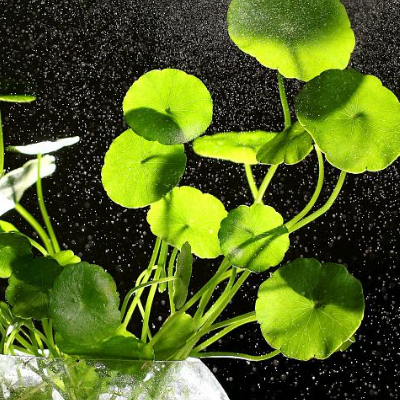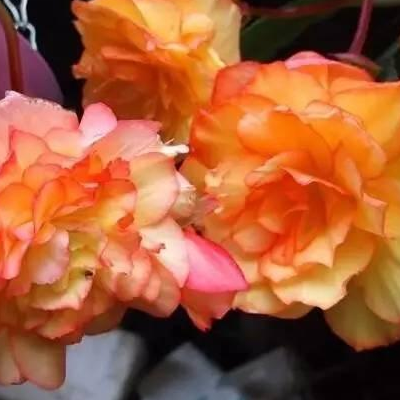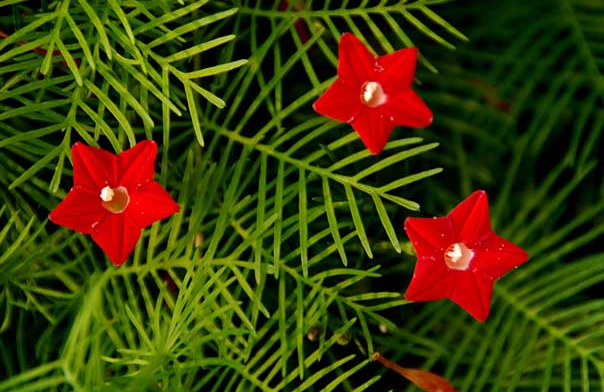How to grow potted Rabdosia angustifolia and how to match it with soil.
Copper money grass, this is a lot of people like to breed, most of the family has this copper money grass, potted copper money grass how to raise burst pot:

4. 3% rotten cake fertilizer can be added to the culture soil as base fertilizer. The alum fertilizer made from cake fertilizer and ferrous sulfate retting was watered once a week during the growing season, 0.1% potassium dihydrogen phosphate solution was irrigated once or twice in the bud period, and the fertilizer was stopped when the temperature was above 35 ℃ in summer and below 15 ℃ in autumn.
Cuckoo
Rhododendron has bright colors and a long flowering period. some flower friends say it is easy to raise, some say it is not easy to raise, but in the final analysis, you have to master its habits!
Maintenance methods:
1. Soil: rotten leaf soil, coarse river sand and sandy loam are mixed into culture soil according to the proportion of 2:1:1, and it is better to use pine needle soil under the condition.
2. In winter, because the sunshine is short and the light is soft, it must be placed on the sunny south windowsill or south balcony indoors to fully receive the light.
3. "apply thin fertilizer frequently, rather less than more". After diluting with alum fertilizer water and clear water during the growing period, it should be applied every half a month. And be sure to use rotten fertilizer!
Money tree
Money tree, money tree, after raising money tree will give birth to a lot of money! Ahem, the flower is joking, raising the money tree at home is actually the moral of the picture!
Maintenance methods:
1. Light, the money tree is more contradictory, like the light and bear the shade, so it is usually best to put the money tree in the bright living room ~
2. When selecting soil, coarse sand, peat, washed cinder and a small amount of garden soil can be mixed, and its ph value can be adjusted to 6: 6.5 to make it in a micro-acidic state.
3, the money tree is more drought-resistant, so usually do not water too much, it is best to be able to keep the basin soil dry! I'd rather be dry than wet!
Goose palm wood
Goose palm wood, also known as duck foot wood, is now a common plant in the family ~ so, how to maintain this kind of plant?
Maintenance methods:
1. Potted soil, potted soil can generally be mixed with rotten leaf soil or peat soil, garden soil and about 1x4 river sand or perlite, in order to make it fertile and add a small amount of cake fertilizer as base fertilizer.
2. in order to keep the soil moist, water should be watered in time before it is dry. when the weather is dry, plants should be sprayed to humidify ~ lack of water, but it will cause fallen leaves of goose palm wood.
3. Pruning, goose palm wood is easy to germinate and grow branches. Attention should be paid to shaping and pruning in order to keep the plant shape neat and beautiful. Those perennial old branches, when the plant shape is too large, can be re-cut in combination with changing pots before the new buds germinate every year, cutting off the upper branches and leaves and part of the old roots.
Jasmine flower
Who doesn't know about jasmine? Whether it is the catchy folk song or the beautiful posture of jasmine, flower friends are deeply fascinated by her.
The main results are as follows: 1. Jasmine likes slightly acidic soil and lives better in slightly acidic soil. 4 parts of garden soil, 4 parts of compost, 2 parts of river sand or grain bran ash, plus an appropriate amount of fully rotten dried cake and chicken and duck manure, and sift out powder and coarse particles to cover the bottom with coarse particles.
2. Jasmine is not resistant to drought, but it avoids stagnant water, so it is necessary to water more at ordinary times, and it is enough to keep the basin soil moist in winter.
3. The cold resistance of jasmine is very poor. Basically, it will stop growing under 10 ℃. It is best to keep the indoor temperature around 20 ℃ in winter.
Third, lianas recommend clematis
When it comes to lianas, how can we not recommend clematis, the queen of vines? The variety is rich, the design and color is also very bright, but also very hardy ~ are you sure you don't want a hair?
Maintenance methods:
1. Soil, use less courtyard soil as much as possible. It is recommended to mix part of perlite with coarse peat, the proportion is about 6:1. Peat can retain water and fat better, loose and breathable, and adding part of perlite can further enhance water permeability and air permeability.
3. Clematis likes to be fertilised. Only when there is enough fertilizer, can the flowers bloom enough and look good enough! Winter fertilization is to remove some of the topsoil from the flowerpot and re-pile it with 2~5CM 's new peat mixed with a lot of organic fertilizer and bone meal. The spring and autumn temperatures are relatively high, you can use clean liquid fertilizer to irrigate the soil or spray foliage, 2-3 times a month is enough. Stop fertilizing during the high temperature in summer.
4. Watering, there is nothing to say, as long as the soil is well prepared, it is enough to master the principle of watering dry and wet.
Meng Changchun
Vine Changchun, also known as Changchun vine, the flowers come out small, complete five petals Oh ~ looks very neat, the color is also varied, there are purple, red, green.
Maintenance methods:
1, soil, potted vine Changchun can be made of garden soil, rotten leaf soil, slag, the proportion is 3:1:1, if there is no slag, you can use river sand and other larger particles instead.
2, light, vine Changchun light requirements are not strict, however, like the semi-overcast environment, the winter light is relatively mild, there is no problem to accept direct light, but the summer must be shaded.
3, watering, grasp the principle of dry and wet, if you want the vine to grow well, you should keep the basin soil moist during its growth.
4. Apply fertilizer every half a month, and increase the amount of phosphorus and potassium fertilizer 2 or 3 times before flowering.
Pineapple
Pineapple, perhaps most people like to call it five-star flower, because it blossoms like a little star ~ dotted on the green branches and leaves, not to mention, full of fresh breath!
Maintenance methods:
1. Watering, the cultivation of pineapple is very simple, wait until the surface of the soil is dry, watering, it is very easy.
2. Fertilization, pineapple basically does not need fertilization, just mix organic fertilizer into the cultivated soil before planting. However, if you want to blossom more, you can apply thin bean cake water during the growing period.
3. Like places where there is plenty of sunshine, so usually let it bask in the sun as much as possible, of course, shade in summer and full sunshine in winter!
Rose
Do you still need flowers to introduce rose in detail? There are many kinds of roses with different colors. When the rose climbs all over the balcony, please don't stop the flowers from appreciating them!
Maintenance methods:
1. Soil, 5 parts of garden soil, 3 parts of garbage soil, 2 parts of rice chaff ash and proper amount of vegetable cake can be used in the culture soil. Or use 4 parts of horse dung, 4 parts of garden soil, 2 parts of river sand, plus a small amount of vegetable cake and bone meal.
2. Fertilization. The growth and flowering of rose needs a lot of fertilizer, if the fertilizer is insufficient, then the flowers will become small. Applying a little organic fertilizer to the roots in winter can enhance the ability of overwintering cold resistance. Wait until early March, when the rose sprouts, liquid fertilizers such as rotten human feces, bean cakes, chicken and duck dung, fish offal can be applied. When it is about to blossom, one light liquid fertilizer can be applied as appropriate.
3, watering, rose watering is nothing special, that is, potted plants can not accumulate water! And the rose is more resistant to drought, so if you are worried about stagnant water, you can wait until the surface of the basin soil is completely dry before watering.
Flower friends, do you like any of these 20 kinds of flowers?
Move back home as soon as you like!
- Prev

The propagation method of flower bulb root of begonia which caliber to choose in flowerpot
Crabapple flowers, which many people like, how to make crabapple flowers grow more and more? Then it is necessary to understand the bulb propagation method of crabapple flower, and what is the propagation method of begonia flower bulb root: 1. There are a lot of fake bulbs on the market, so partners must pay more attention when buying.
- Next

How to plant the pentagram flower and when to sow it
The five-pointed star flower, this kind of plant blooms that is really super beautiful, is bright red, good to see do not want, how to grow the five-pointed star flower? When to sow the five-pointed star flower: how to plant the five-pointed star flower: 1. Planting: the five-pointed star flower is planted after the final frost, in areas where the night temperature is still relatively low
Related
- Fuxing push coffee new agricultural production and marketing class: lack of small-scale processing plants
- Jujube rice field leisure farm deep ploughing Yilan for five years to create a space for organic food and play
- Nongyu Farm-A trial of organic papaya for brave women with advanced technology
- Four points for attention in the prevention and control of diseases and insect pests of edible fungi
- How to add nutrient solution to Edible Fungi
- Is there any good way to control edible fungus mites?
- Open Inoculation Technology of Edible Fungi
- Is there any clever way to use fertilizer for edible fungus in winter?
- What agents are used to kill the pathogens of edible fungi in the mushroom shed?
- Rapid drying of Edible Fungi

